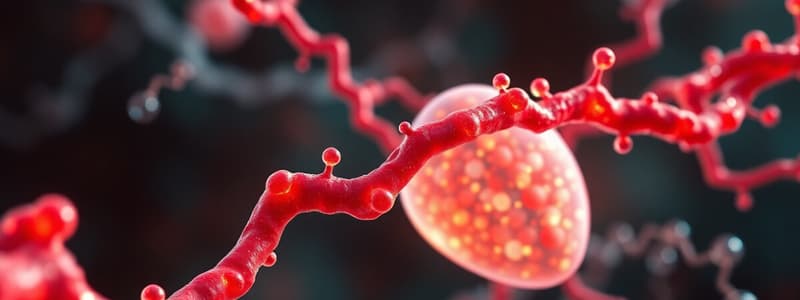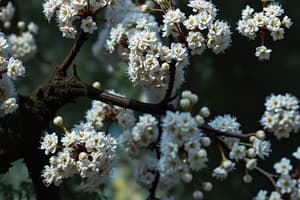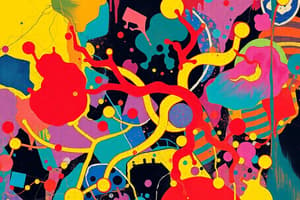Podcast
Questions and Answers
What is the primary configuration indicated in the nomenclature of cardioactive glycosides?
What is the primary configuration indicated in the nomenclature of cardioactive glycosides?
- Presence of specific enzymes
- Type of sugar used
- Exact molecular weight
- Order of the functional groups (correct)
Cardenolide refers to a cardioactive glycoside with three double bonds.
Cardenolide refers to a cardioactive glycoside with three double bonds.
False (B)
Name one glycoside contained in Digitalis purpurea.
Name one glycoside contained in Digitalis purpurea.
Digitoxin
Bufadienolides are derived from the condensation of a C21 steroid and a ________ unit.
Bufadienolides are derived from the condensation of a C21 steroid and a ________ unit.
Match the following Digitalis species with their glycosides:
Match the following Digitalis species with their glycosides:
What does the 'β' denote in the nomenclature sequence of cardioactive glycosides?
What does the 'β' denote in the nomenclature sequence of cardioactive glycosides?
The average concentration of glycosides in Digitalis purpurea is approximately 0.16%.
The average concentration of glycosides in Digitalis purpurea is approximately 0.16%.
What is the main precursor for the biosynthesis of aglycones in cardiac glycosides?
What is the main precursor for the biosynthesis of aglycones in cardiac glycosides?
Acetyl derivatives of purpurea glycosides include Lantoside A, B, and E, which are named ________, respectively.
Acetyl derivatives of purpurea glycosides include Lantoside A, B, and E, which are named ________, respectively.
Which type of glycoside has no double bond?
Which type of glycoside has no double bond?
What is the primary mechanism of action for cardiac glycosides?
What is the primary mechanism of action for cardiac glycosides?
K-strophanthoside is the main glycoside found in both Strophanthus kombe and Strophanthus hispidus.
K-strophanthoside is the main glycoside found in both Strophanthus kombe and Strophanthus hispidus.
Name one plant that contains cardiac glycosides and has been used to treat cardiac insufficiency.
Name one plant that contains cardiac glycosides and has been used to treat cardiac insufficiency.
Strophanthin is used ___ for prompt therapeutic effect.
Strophanthin is used ___ for prompt therapeutic effect.
Match the following cardiac glycosides with their sources:
Match the following cardiac glycosides with their sources:
Which glycoside is NOT recommended for oral administration due to unsafe absorption?
Which glycoside is NOT recommended for oral administration due to unsafe absorption?
Oleander is considered safe for all animal consumption.
Oleander is considered safe for all animal consumption.
What distinguishes the genins of squill glycosides from those of cardenolides?
What distinguishes the genins of squill glycosides from those of cardenolides?
What types of lactone rings can be found in cardioactive glycosides?
What types of lactone rings can be found in cardioactive glycosides?
The dried ripe seeds of _______ kombe are known as Strophanthus.
The dried ripe seeds of _______ kombe are known as Strophanthus.
What component is K-strophanthoside based on?
What component is K-strophanthoside based on?
Cardioactive glycosides always contain an ester group at R1 and R2 positions.
Cardioactive glycosides always contain an ester group at R1 and R2 positions.
What is the main effect of cardioactive glycosides on cardiac muscle?
What is the main effect of cardioactive glycosides on cardiac muscle?
The glycone portion at position C-3 of cardiac glycosides may contain up to ___ monosaccharide molecules linked in series.
The glycone portion at position C-3 of cardiac glycosides may contain up to ___ monosaccharide molecules linked in series.
Match the following terms with their descriptions:
Match the following terms with their descriptions:
Which one of the following statements is a feature of cardioactive glycosides?
Which one of the following statements is a feature of cardioactive glycosides?
The structure referred to as cardiac genin is a steroidal compound.
The structure referred to as cardiac genin is a steroidal compound.
The presence of another β-OH group at position C-___ is a characteristic of cardioactive glycosides.
The presence of another β-OH group at position C-___ is a characteristic of cardioactive glycosides.
Name two examples of glycosides classified as cardenolides.
Name two examples of glycosides classified as cardenolides.
Which functional groups may also be present in cardioactive glycosides?
Which functional groups may also be present in cardioactive glycosides?
Flashcards are hidden until you start studying
Study Notes
Cardioactive Glycosides
- Cardioactive glycosides are a group of glycosides that specifically target cardiac muscle, increasing its tone, excitability, and contractility.
- The aglycones of these glycosides are referred to as "cardiac genin" and are steroidal in nature, specifically derivatives of cyclopentaphenanthrene with an unsaturated lactone ring attached to C17.
- Two types of genin are distinguished based on their lactone ring:
- Cardenolides: Contain a five-membered lactone ring (e.g., digitoxigenin)
- Bufadienolides: Contain a six-membered lactone ring (e.g., scillarenin)
- Cardenolides have a butenolide (4 carbons) lactone ring attached at C17, also known as an α,β-unsaturated lactone ring. Examples include glycosides of digitalis and strophanthus species.
- Bufadienolides have a pentadienolide (5 carbons with two double bonds) lactone ring attached at C17, also called a pentenolide. Examples include squill glycosides and Bufotoxin.,
Characteristics of Cardioactive Glycosides
- β-OH at position C-3: Always involved in a glycosidic linkage to a mono, di, tri, or tetrasaccharide.
- β-OH group at C-14.
- Unsaturated 5 or 6-membered lactone ring at position C-17: In the β configuration.
- Additional OH groups may be present at C-5, C-11, and C-16.
Nomenclature of Cardioactive Glycosides
- Nomenclature follows a specific sequence:
- Functional groups and their configuration are arranged.
- Whether α or β is denoted.
- The type of glycoside is denoted.
- The position of the double bonds is denoted.
Biosynthesis of Cardioactive Glycosides
- Aglycones are derived from mevalonic acid.
- Final molecules arise from a condensation of a C21 steroid with a C2 unit (source of C-22 and C-23).
- Bufadienolides are condensation products of a C21 steroid and a C3 unit.
Digitalis (Foxglove)
- Dried leaves of Digitalis purpurea (F: Scrophulariaceae).
- "Digitalis" comes from the Latin "digitus" meaning finger, referring to the finger-shaped corolla; "purpurea" refers to the purple color of the flower.
- Contains a large number of glycosides, the most important from a medicinal standpoint being Digitoxin, Gitoxin, and Gitaloxin.
- Average concentration in the drug is about 0.16%.
- Other glycosides include: purpurea glycosides A, purpurea glycoside B, gluco-gitaloxin, gluco-digitoxigenin.
- Primary glycosides have acetylated sugar moieties.
Digitalis lanata
- Leaves contain nearly 70 different glycosides.
- All are derivatives of five different aglycones, three of which (digitoxigenin, gitoxigenin, and gitaloxigenin) are also found in Digitalis purpurea.
- The other two types of glycosides are derived from digoxigenin and diginatigenin, which are found in Digitalis lanata but not Digitalis purpurea.
- Leaves are used as a source of the glycosides digoxin and lanatoside C.
Mechanism of Action
- Inhibits Na+/K+ ATPase enzyme (a membrane-bound enzyme).
- This enzyme maintains K+ inside the cell and Na+ outside the cell. When inhibited, K+ transport back into the cell is blocked, increasing its concentration in the extracellular fluid.
- Na+ ions enter the cell, promoting or facilitating the entry of Ca +2.
- Ca +2 is essential for the contraction of actin and myosin.
- Therefore, these agents are used in the treatment of congestive heart failure.
Strophanthus
- Dried ripe seeds of Strophanthus kombe or Strophanthus hispidus (F: Apocyanaceae).
- Principal glycosides are K-strophanthoside, K-strophanthin-B, and cymarin, all based on the genin strophanthidin.
Constituents of Strophanthus
- K-strophanthoside, also known as strophoside.
- Main glycoside in both S. kombe and S. hispidus.
- Composed of the genin strophanthidin coupled to a trisaccharide consisting of cymarose, β-glucose, and α-glucose.
- Used intravenously as a cardiotonic.
- Ouabin (G-strophanthin)
- Obtained from S. grantus (F: apocynaceae).
- Most polar cardioactive glycoside.
- Acts as a cardiotonic, administered intravenously for a prompt therapeutic effect.
- Absorbed so slowly and irregularly from the alimentary canal that oral administration is not recommended and is even considered unsafe.
- Ouabagenin
- The sugar is rhamnose.
- Differs from K-strophanthidin by having 2 additional (OH) groups at C-1 and C-11 and having an alcoholic group at C-10 instead of the aldehydic group.
Oleander
- Leaves of Nerium oleander (F: Apocyanaceae) have been used to treat cardiac insufficiency.
- Main constituent is oleanderin, which is a promising agent for anticancer treatment.
- Historically considered a poisonous plant due to the toxicity of some compounds, especially to animals, when consumed in large amounts.
Squill (Bufadienolide)
- The bulb of the white variety of Urginea maritima (known as white or Mediterranean squill) or Urginea indica (known in commerce as Indian squill) (F: liliaceae).
- Genins of squill glycosides differ from those of cardenolides in two significant aspects:
- They have a six-membered doubly unsaturated lactone ring at position C-17.
- They have at least one double bond in the steroid nucleus.
Studying That Suits You
Use AI to generate personalized quizzes and flashcards to suit your learning preferences.




